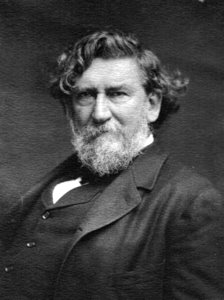
Thomas Satterwhite Noble (May 29, 1835 – April 27, 1907) was an American painter as well as the first head of the McMicken School of Design in Cincinnati, Ohio.
Noble was born May 29, 1835 in Lexington, Kentucky, and raised on a plantation where hemp and cotton were grown. He showed an interest and propensity for art at an early age. He first studied painting with Samuel Woodson Price in Louisville, Kentucky, in 1852 and then continued his studies with Price, Oliver Frazier and George P.A. Healey at Transylvania University in Lexington. In 1853 he moved to New York, New York, before moving to Paris to study with Thomas Couture from 1856 to 1859.
Noble then returned to the United States in 1859 intending on beginning his art career. However, with the beginning of the Civil War, as a Southerner, he served in the Confederate army from 1862 to 1865. After the war, Noble was paroled to St. Louis and began painting. With the success of his first painting, Last Sale of the Slaves, he received sponsorship from wealthy Northern benefactors for a studio in New York City. Noble lived in New York city from 1866 to 1869, during which time he painted some of his most well-known oil paintings. In 1869, he was invited to become the first head of the McMicken School of Design in Cincinnati, Ohio, a post he would hold until 1904. In 1887, the McMicken School of Design became the present-day Art Academy of Cincinnati. During his tenure at the McMicken School of Design, Noble moved briefly to Munich, Germany, where he studied from 1881 to 1883. He retired in 1904 and died in New York City on April 27, 1907. He is buried in Spring Grove Cemetery in Cincinnati.
Noble's well-known works are largely historical or social/political presentations. He is best known for a series of four anti-slavery paintings. The first, Last Sale of the Slaves (1865) depicted the scene of the last sale of the slaves on the St. Louis courthouse steps. He followed this painting with John Brown's Blessing (1866) which depicted the abolitionist activist John Brown being led to his execution and blessing a child on the steps of the courthouse. His third painting, The Modern Medea (1867), portrayed the tragic event from 1856 in which Margaret Garner, a fugitive slave mother, murdered her children rather than see them returned to slavery. The picture is notable for Garner's expression of rage and for including the white slave hunters in the imagery. Noble's last painting, Price of Blood (1868), was not based on a specific historical event, but depicted a white slave owner selling his half-white slave son. As with The Modern Medea, this painting is unique for the era with the inclusion of the white perpetrators in the imagery.
Noble's artwork has been exhibited in over 70 exhibitions, both during his lifetime and after his death. Most of his well-known initial works are historical presentations, painted to make strong political and moral commentary. Later in his life he painted many allegorical images, often having his children pose for figures in the paintings. After studying in Munich and towards the end of his life, Noble focused his artistic work on landscapes of Ohio and Kentucky countryside and Bensonhurst, New York.
His most well-known paintings are Last Sale of the Slaves, John Brown's Blessing, Price of Blood and Margaret Garner. Each depicts a specific horror of slavery: in Last Sale of the Slaves, the selling of a mother and child; in Price of Blood, the selling of a son by the slave owner; in Margaret Garner, a mother killing her children rather than subjecting them to slavery. Noble also sketched a well-known lithograph for Harper's weekly based on his John Brown's Blessing.